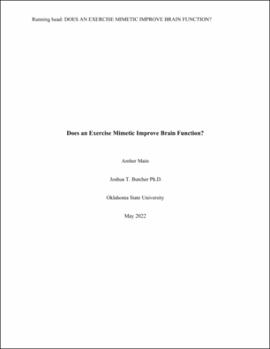| dc.contributor.author | Main, Amber | |
| dc.date.accessioned | 2022-05-09T14:28:05Z | |
| dc.date.available | 2022-05-09T14:28:05Z | |
| dc.date.issued | 2022-04-15 | |
| dc.identifier | oksd_main_HT_2022 | |
| dc.identifier.uri | https://hdl.handle.net/11244/335614 | |
| dc.description.abstract | Alzheimer's (AD) and vascular dementia (VD) have become increasingly prevalent in elderly populations in the U.S. in recent years. In addition to cognitive decline, another developing health risk is loss of skeletal muscle mass and function in the aged. A lack of activity is a significant risk factor for the progression of AD/VD in later life, and exercise has been shown to prevent or blunt the progression of these diseases. It has been shown that brain tissue in those afflicted with AD/VD is exposed to higher levels of oxidative stress, an imbalance in the production of reactive oxygen species (ROS) and antioxidant defenses. Exercise is known to reduce oxidant stress, but the aged are not always able to exercise at a level that conveys benefit. The deletion of myostatin, a negative muscle regulator protein, has been shown to increase muscle mass and improve glucose handling, which improves oxidant stress. | |
| dc.description.abstract | In our lab, we use mouse models of myostatin (myo) deletion in young and aged mice, as well as examining sex differences. Our groups include lean control and lean muscular (MYO KO) in both sexes at 12- 20 months old (20-30 years old in humans) and 24-28 months old mice (69-81 years old in humans). We sacrifice mice and use fine dissection to carefully isolate and remove carotid arteries. These tissues have been analyzed for oxidant stress enzymes (ex: NOX1, NOX2, and NOX4). We also used pressure myography to examine vascular function. We observed animal movement using San Diego Instruments Photobeam Activity System (SID PAS) to assess fine motor skills, balance and rearing. This is an in vivo non-terminal experiment that resides in our lab. We found that myostatin deletion in young mice reduces the oxidant stress enzyme NOX1 and upregulates the antioxidant NOX4. In aged control mice, we see endothelial function is impaired but returned to the level of control with myostatin deletion. Importantly, we observed that, with aging, both fine motor, balance, and rearing is impaired, but that myostatin deletion improved all aspects of motor function. Interestingly, this improvement in motor function was especially significant in the aged male mice. | |
| dc.format | application/pdf | |
| dc.language | en_US | |
| dc.rights | Copyright is held by the author who has granted the Oklahoma State University Library the non-exclusive right to share this material in its institutional repository. Contact Digital Library Services at lib-dls@okstate.edu or 405-744-9161 for the permission policy on the use, reproduction or distribution of this material. | |
| dc.title | Does an exercise mimetic improve brain function? | |
| osu.filename | oksd_main_HT_2022.pdf | |
| osu.accesstype | Open Access | |
| dc.type.genre | Honors Thesis | |
| dc.type.material | Text | |
| dc.subject.keywords | myostatin | |
| dc.subject.keywords | oxidative stress | |
| dc.subject.keywords | reactive oxygen species | |
| dc.subject.keywords | Alzheimer's | |
| dc.subject.keywords | NOX1 | |
| dc.subject.keywords | NOX2 | |
| dc.subject.keywords | NOX4 | |
| dc.contributor.director | Butcher, Joshua T. | |
| dc.contributor.facultyreader | Rudd, Jennifer | |
| thesis.degree.discipline | Physiology | |
| thesis.degree.grantor | Oklahoma State University | |
